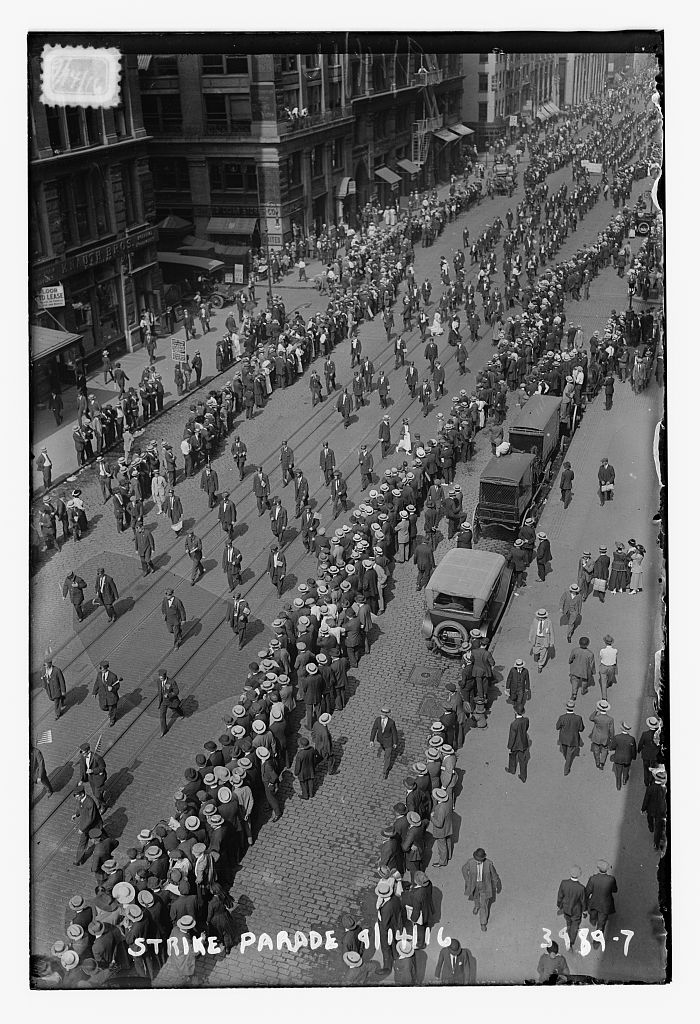NHD Bibliography

Primary Sources
Albee, S. V., Publisher, Albee, S. V, photographer. “Cannon shot fired through stove pipe into locomotive, near sand box, Pittsburgh, PA.” Library of Congress. Seth Vose Albee, 1877. https://www.loc.gov/item/2024722941/.
We used this to show how much combat, and damage could take place in strikes. It was important to information on how the 1877 strike occurred.
August 26 Women's Strike Committee, Sponsor/Advertiser. “Women's Strike, August 26.” Library of Congress. Gary Yanker, August 26,1971. https://www.loc.gov/item/2015648058/.
This shows how word about strikes was spread. It also is an example of the posters used.
Bain, George Grantham. “Strike parade.” Library of Congress. Bains News Service, August 1916. https://www.loc.gov/item/2014702808/.
This is used to show just how big some strikes were, in an easy to see view.
Bain, George. “Strike pickets.” Library of Congress. Bains News Service, February, 1910. https://www.loc.gov/pictures/item/2014684501/
This shows how strikers were not limited to one gender. This is how women got rights before they could vote.
Baker, Ray. “Living conditions among the poor during depression & pullman strike, Chicago, 1893.” Library of Congress. Ray Stannard Baker, 1893. https://www.loc.gov/item/2006690038/.
This shows the extent of the depression, which gives context for why the strike occurred and why rioters took it so seriously.
Jarvis, J.F., publisher. “The Homestead strike, 1892.” Library of Congress. J.F. Jarvis, publisher, 1892. https://www.loc.gov/item/2005684354/.
This is a collection of photos that demonstrated various aspects of the homestead strike. This was used to show the militarization.
Leslie, Frank. “The great railroad strike of July 1877.” Library of Congress. Frank Leslie’s Illustrated Newspaper, August 11, 1877. https://www.loc.gov/item/2007675388/.
This shows many scenes, including the violence in the rebuke of this strike. It also shows the damage rioters did.
National Committee for Organizing Iron and Steel Workers. “A Steelworkers’ Ballot Calls “Strike!” in Many Tongues.” SHEC: Resources for Teachers. American Social History Project Center for Media and Learning, 1920. https://shec.ashp.cuny.edu/items/show/1135
This shows how useful the unions were, for it would not be united in as many tongues without it.
Stowell, Myron R. "Fort Frick". Library of Congress. Pittsburg printing co, 1893. https://www.loc.gov/item/07029949/.
This was used to give us more information on the Homestead Strike, as well as images.
U.S. Senate. “A Steelworker strikes for ‘Eight Hours a Day and Better Conditions’.” SHEC: Resources for Teachers. American Social History Project Center for Media and Learning, https://shec.ashp.cuny.edu/items/show/815
This interview shows what strikers want. This is important to how they thought.
Secondary Sources
Adamczyk, Joseph. “Great Railroad Strike of 1877.” Britannica. Britannica, September 5th, 2014. https://www.britannica.com/topic/Great-Railroad-Strike-of-1877
We used this as another example of early striking violence. It appears to be a trend in early strikes.
Adamczyk, Joseph. “Homestead Strike.” Brittanica. Britannica, March 6th, 2014. https://www.britannica.com/event/Homestead-Strike
We used this to show the dangers of strikes. When the steel workers went on strike, and the company tried to hire replacement workers, an actual battle occurred.
The Editors of Encyclopaedia Britannica. “Smith-Connally Anti-Strike Act.” Britannica. Britannica, July 20th, 1998. https://www.britannica.com/topic/Smith-Connally-Anti-Strike-Act
This is one of the pieces of legislation that damaged strikers' rights. We used this to show how legislation can be harmful to workers’ rights.
Tabor, Nick. “Memphis Sanitation Workers’ Strike.” Britannica. Britannica, May 21st, 2024. https://www.britannica.com/event/Memphis-sanitation-workers-strike
This is used as an example of the far-reaching repercussions. Because of this strike MLK Jr. was in Memphis and was killed.
The Editors of Encyclopaedia Britannica. “Boston Police Strike.” Britannica. Britannica, Jul 20, 1998. https://www.britannica.com/event/Boston-Police-Strike
We used this to show the danger of government involvement in strikes. Calvin Coolidge refused to prevent the strike but then sent the Massachusetts militia once the situation was in control.
The Editors of Encyclopaedia Britannica. “Wagner Act.” Britannica. Britannica, July 20th, 1998. https://www.britannica.com/topic/Wagner-Act/additional-info#history
We found that this was the most important piece of labor legislation in the 20th century and used it to further reinforce that there has been government legislation to help with bargaining and unions.
The Editors of Encyclopaedia Britannica. “Taft-Hartley Act.” Britannica. Britannica, July 19th, 1998. https://www.britannica.com/money/Taft-Hartley-Act
We used this to show how the government can damage helpful labor legislation.
The Editors of Encyclopaedia Britannica. “Landrum-Griffin Act.” Britannica. Britannica, July 19th, 1998. https://www.britannica.com/money/Landrum-Griffin-Act
We used this finding that it simply made the T-H-Act worse, expounding upon it.
Tabor, Nick. “Memphis Sanitation Workers’ Strike.” Britannica. Britannica, May 21st, 2024. https://www.britannica.com/event/Memphis-sanitation-workers-strike
This is used as an example of the far-reaching repercussions. Because of this strike MLK Jr. was in Memphis and was killed.
Urofsky, Melvin. “Pullman Strike.” Britannica. Britannica, July 20th 1998. https://www.britannica.com/event/Pullman-Strike
We learned that this strike had negative consequences, it was forcibly ended by the government and the military. The only good thing that it did was create Labor Day.

